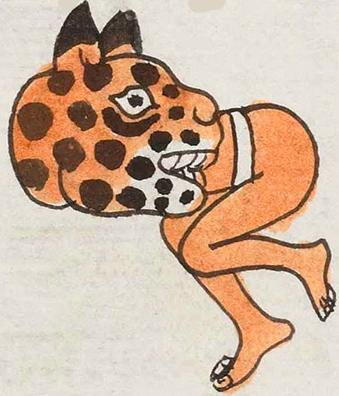tecualo (Mdz34r)
This simplex glyph of a person being eaten (with the passive voice) also stands for the place name, Tecualoyan. It shows a jaguar head with the lower end of a human (male, judging by the loincloth waist belt) body sticking out from the jaws.
Stephanie Wood
A verb lies at the root of the place name, referring to people being bitten or eaten. The verb cua, at the very root, often came to have tla- in front of it, but the prefix te- is also known. A related concept is found in the word tecuani, which is an animal that eats or bites humans, a wild animal, a dangerous animal.
Stephanie Wood
Stephanie Wood
by 1553 at the latest
Stephanie Wood
bites, eats, man-eating animal

cua, to eat, to bite, https://nahuatl.wired-humanities.org/content/cua
te- (nonspecific human object prefix), https://nahuatl.wired-humanities.org/content/te
-lo (passive tense indicator), https://nahuatl.wired-humanities.org/content/lo
to bite or eat humans
comer o morder a la gente
Stephanie Wood
Codex Mendoza, folio 34 recto, https://digital.bodleian.ox.ac.uk/objects/2fea788e-2aa2-4f08-b6d9-648c00..., image 78 of 188.
The Bodleian Libraries, University of Oxford, hold the original manuscript, the MS. Arch. Selden. A. 1. This image is published here under the UK Creative Commons, “Attribution-NonCommercial-ShareAlike 3.0 License” (CC-BY-NC-SA 3.0).

